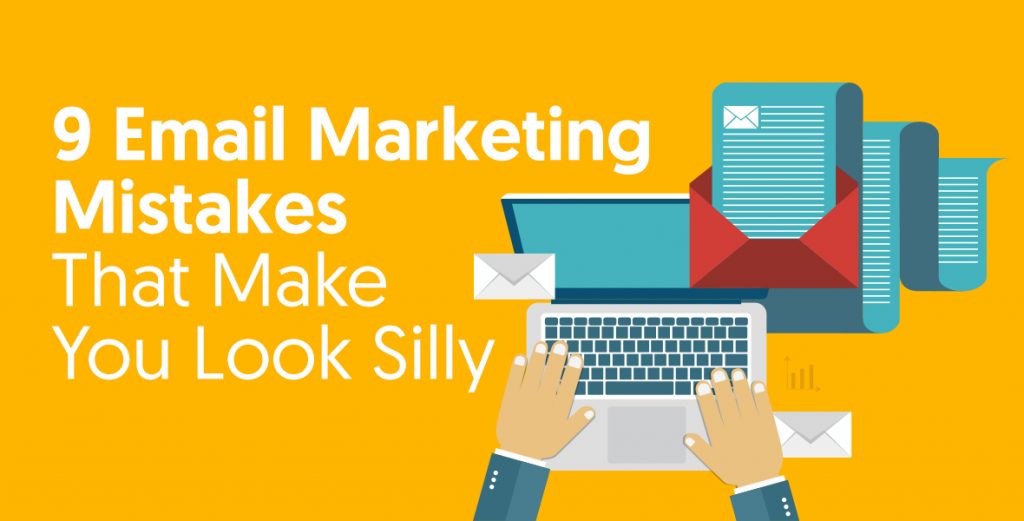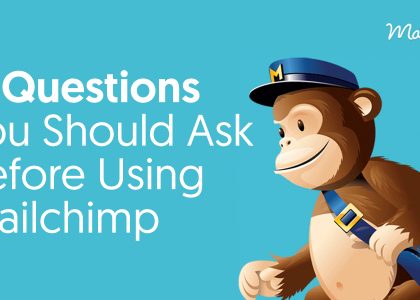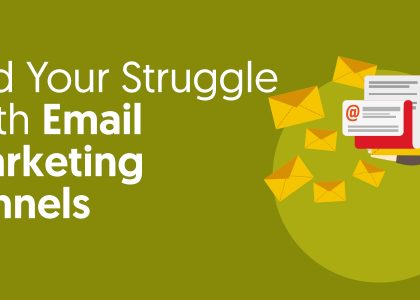9 Email Marketing Mistakes That Make You Look Silly

If you’re not making mistakes, then you’re not doing anything. I’m positive that a doer makes mistakes.- John Wooden
Great email marketing demands great communication.
Great communication requires diplomacy. That means you need tact, thoughtfulness, and circumspection. Unfortunately, many businesses do not apply these virtues to their email marketing campaigns. When it comes to emails, every mistake you make can damage your reputation.
How do you know if you’re trotting down the wrong track? Results. If your emails aren’t generating sales and leads, it means that your email marketing process needs an overhaul.
We are going to list some of the biggest email marketing mistakes. Clean up these mistakes to avoid looking silly in your next campaign.
1. Misusing the Signup Form
Many marketers believe serious mistakes primarily happen while drafting your email copy. The truth is, major mistakes can happen long before that. They often start with your signup form.
How can you make a fantastic signup form?
Make sure your signup form is functional, visible, and attractive. You also want to nail your form fields. Less fields is not always more. Check out this quote by Michael Aagaard from Unbounce,
I removed all the fields that people actually want to interact with and only left the crappy ones they don’t want to interact with. Kinda stupid. It’s very difficult to solve a problem you don’t understand. Vice versa, it’s pretty easy to solve a problem you do understand.”
You want to collect the information you need to help. For instance, let’s say you provide a flyer distribution service in five Chinese cities. You should ask leads what city they’re from, so you can provide targeted emails. If you’re in doubt, erase the field. Yet, erasing fields isn’t the clear path to success.
2. Using Extravagant Subject Lines
If You Promise the Moon, Deliver the Stars
You know about BuzzFeed. They allegedly made 250 million dollars in 2015, primarily using the power of clickbait headlines. “Clickbait” headlines are used everywhere from Hubspot to unethical internet marketers. So, are they right for your emails?
It depends. The most disliked thing about BuzzFeed is their subject lines are overhyped. Some of their headlines don’t deliver on the promise. Even if professionals like Hubspot use sensational headlines, they deliver on those headlines.
A good subject line must be relevant to the content you provide. Yet, adding flash is proven to increase conversions. Use Coschedule’s Headline Analyzer to start crafting better headlines. The tool promises that you’ll increase your engagement, which means you’ll grab more email opens. Always deliver on the promise of the headline so you don’t only see a transitory effect.
3. Using a No Reply Email Address
Imagine a brand that sends email using a “no-reply” address. It’s not as far-fetched as it sounds. Brands make this mistake all the time.
You want people to view you as an accessible company. You want to be known as someone that replies to user’s concerns. This is why a contact address is much needed, for example: [email protected], or better yet [email protected].
No-reply email addresses costs you sales too. Sometimes people want to reply directly to your email. A no-reply email address discourages direct responses, queries which may lead to a sale. Email is a two-way communication tool.
4. The Email’s Content Offers No Value
Marketers send emails that contain no valuable content all the time. It’s an offensive proposition. It’s like saying “Hey, give us money while we offer you absolutely nothing!” You don’t want to be a leech; they lose their tribe quickly.
What does providing value mean? It’s an overused term these days.
Providing value starts with your audience. What’s valuable to one audience, isn’t valuable to another. It even gets more granular than that. What’s valuable to one part of your email list may not be the valuable to the rest of your list. That’s why email segmentation is critical. For instance, ESPN asks you what sports you like when you sign up for their website. Hockey emails don’t have value to people who are there strictly for the NFL.
Valuable content gets shared more. This causes a snowball effect that increases the size of your email list. Yet, it’s about more than one marvelous email. The biggest mistake marketers make with value is the lack of regularity. You have email marketing software. You know what emails people are interacting with. Build up goodwill by sending more of that content.
5. Too Many CTA’s (Calls To Action)
If you chase two rabbits, you will catch neither one. – Russian Proverb
When it comes to CTA buttons, less is almost always more. You don’t want to confuse your prospects.
You have a lot to say. That’s great. You want to tell your prospects about your new ebook. Likewise, you want to share your updated homepage, your guest post on Kissmetrics, and your latest YouTube tutorial.
Using too many CTA’s will bewilder your prospects. Your CTA button needs to have a clear goal. This is particularly true if you’re selling something. For instance, in the example above, you’re promoting your new ebook. You want as many eyeballs as possible on that ebook landing page. Wishpond says it best,
“Asking visitors to complete multiple actions can lead to a decrease in conversions. Always have one goal for your landing page, and one goal only.”
Multiple CTA buttons are okay if your email doesn’t have a clear goal. For instance, you can have a lot of links in a roundup post or a “best of” newsletter. Yet, people get distracted easily. If you want to sell something, don’t send them off page.
6. Long Emails
According to Goodreads, The Count of Monte Cristo is 1276 pages long. This tale of revenge is an epic classic, a whopper of a book. As a matter of fact, many classic books are long. Therefore people assume effective email marketing copy can be lengthy.
It’s not. Effective email marketing is succinct; it doesn’t go on tangents. People who read long books and articles typically set aside time to read them. Yet, email readers are usually sandwiching reading in between other tasks.
Long emails are going to lower your engagement. Worst of all, they use too much of your time and energy. You could be investing that time into creating elite content, such as an infographic or high-quality article.
Keep your emails clean, simple and short.
7. Using Only Images as Content
Email only images are likely to alert the spam filters. That’s because ISP’s can’t read the text in an image. Many scammers put their text in an image to elude detection. As a result, ISP’s are wary about emails that only use images.
There are other issues too. Every inch of real estate is valuable in email marketing. This includes the preview text, which highlights text in your email. If your email is only an image, the preview will only display the image file name. A preview of technical jargon is not going to entice people to click.
Lastly, images take a long time to load. Sometimes images don’t render so you have to suspend the ad blocker. Typically, it takes longer to open emails that are image heavy. Whatever the case, it lowers engagement.
Don’t rely on images only.
8. Inconsistency
“Consistency is the true foundation of trust.” – Roy T. Bennett
Email marketing without a schedule is like Robin Hood without his bow and arrow. It works, but there’s something central that’s missing. Prospects love to see consistency in your emails. It radiates professionalism, while inconsistency communicates amateurism.
For instance, if you send every week, then don’t go two months without updating your tribe. If you send every day, don’t go two weeks without updating your subscribers. Email marketing in spurts will cause your prospects to forget you. Your email marketing plan should be like clockwork.
Media Post says that marketers send an average of five times a month. This is a good number to aim for if you’re unsure. Yet, consistency is about more than the number. Don’t cram posts at the end of the month to reach your number.
Let’s say you want to grow a tree in your backyard. Do you soak the tree once in a blue moon and expect it to grow? The same idea applies to email marketing. It’s a continual effort.
9. Sending to an Unhealthy List
In the book The Wizard of Oz, the wizard lived in the Emerald City, a place where everything was green. It turns out everything wasn’t green. The wizard made people wear green spectacles that colored their vision. The people thought everything was green, but it really wasn’t.
Marketers wear green spectacles when it comes to bad email lists. These lists are useless. They’re full of spam traps, complainers, duplicate emails, and other undesirable traits. The idea is that a few of these people will click. Something is better than nothing, right?
Wrong. Delivering to low quality addresses can get you placed on filters like Spamhaus. It can lower your reputation. That makes it harder to deliver to the people who really want your emails. The green spectacles are deceiving. Delivering to those extra (bad) addresses will actually shrink your audience.
The Silliest Email Marketing Mistake
Email marketing is bigger than ever. Companies that are good at email marketing generate more leads at a lower cost. So, the silliest email marketing mistake is not refining your strategy.
What’s the silliest email marketing mistake you’ve made? Let us know in the comments below.






